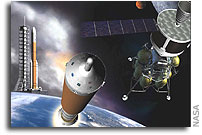NASA ESAS Final Report November 2005: Section 5.0 Crew Exploration Vehicle

 Editor’s note: DOWNLOAD THIS SECTION (PDF)
Editor’s note: DOWNLOAD THIS SECTION (PDF)
Editor’s note: several days ago we posted a final (October 2005) draft of this report. We have since come across a complete copy of the final version of the report (November 2005) which has recently been approved by NASA Administrator Michael Griffin. In order to present the most accurate version of this report, we have removed the draft version and replaced it with the final version of the report. NASA is expected to publicly release this report in early January 2006.
5. Crew Exploration Vehicle
5.1 CEV Overview and Recommendations
One of the keys to enable a successful human space exploration program is the development and implementation of a vehicle capable of transporting and housing crew on Low Earth Orbit (LEO), lunar and Mars missions. A major portion of the Exploration Systems Architecture Study (ESAS) effort focused on the definition and design of the Crew Exploration Vehicle (CEV), the the fundamental element by which NASA plans to accomplish these mission objectives.
This section provides a summary of the findings and recommendations specific to the CEV. While the CEV design was sized for lunar missions carrying a crew of four, the vehicle was also designed to be reconfigurable to accommodate up to six crew for International Space Station (ISS) and future Mars mission scenarios. The CEV can transfer and return crew and cargo to the ISS and stay for 6 months in a quiescent state for emergency crew return. The lunar CEV design has direct applications to International Space Station (ISS) missions without significant changes in the vehicle design. The lunar and ISS configurations share the same Service Module (SM), but the ISS mission has much lower delta-V requirements. Hence, the SM propellant tanks can be loaded with additional propellant for ISS missions to provide benefits in launch aborts, on-orbit phasing, and ISS reboost. Other vehicle block derivatives can deliver pressurized and unpressurized cargo to the ISS.
Table of Contents
This large 50 MB PDF report has been subdivided into 17 PDF files – one for each of the report’s 17 sections. Click on the link at the top of each section to visit a summary page and to download that section.
Editor’s note: several days ago we posted a final (October 2005) draft of this report. We have since come across a complete copy of the final version of the report (November 2005) which has recently been approved by NASA Administrator Michael Griffin. In order to present the most accurate version of this report, we have removed the draft version and replaced it with the final version of the report. NASA is expected to publicly release this report in early January 2006.
- 1. Executive Summary
- 2. Introduction
- 3. Ground Rules and Assumptions
- 4. Lunar Architecture
- 5. Crew Exploration Vehicle
- 6. Launch Vehicles and Earth Departure Stages
- 7. Operations
- 8. Risk and Reliability
- 9. Technology Assessment
- 10. Test and Evaluation
- 11. Integrated Master Schedule
- 12. Cost
- 13. Summary and Recommendations
- 14. Architecture Roadmap
- 15. Architecture Advantages
- 16. ESAS Core Team Members
- 17. Acronyms and Abbreviations








